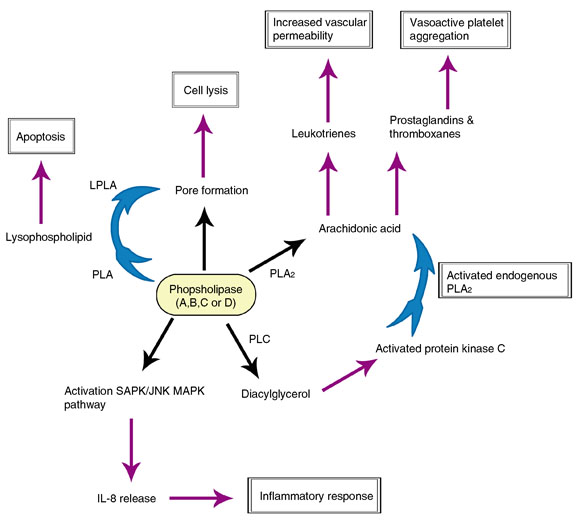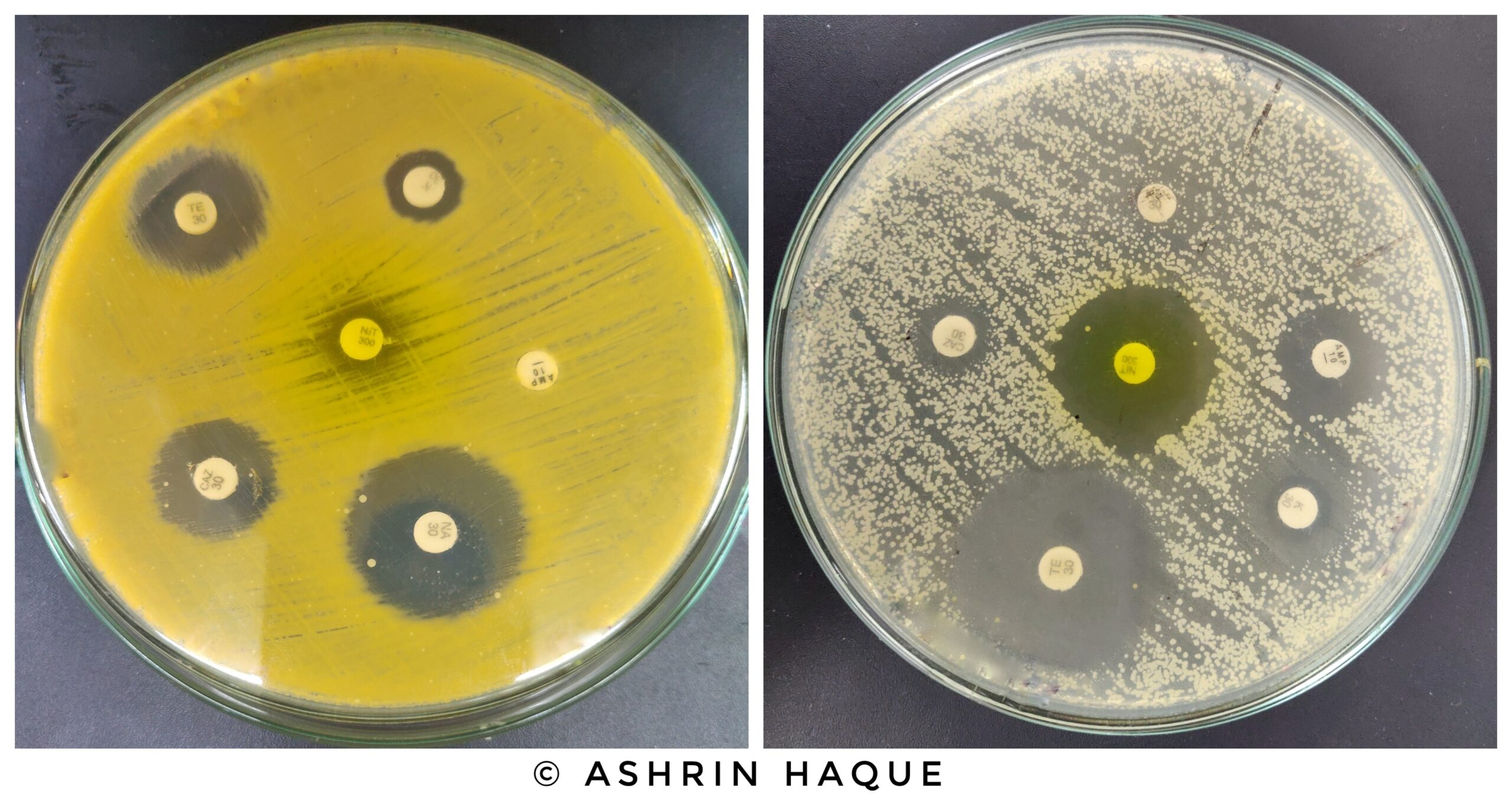Virulence is an agent or organism’s ability to infect the host & to cause infection leading to disease. Virulence factors or properties play a crucial role in making a pathogen susceptible to causing disease as these molecules assist the pathogen (bacteria) to colonize at the host’s cellular level. So, these virulence factors in nature can be either cytosolic, secretory, or membrane-associated where secretory factors act as an armory for bacteria to escape or wade through the host’s innate & adaptive immune response. Besides, cytosolic factors make it easy for bacteria to quickly adapt & undergo morphological, metabolical, and physiological shifts & membrane-associated factors help bacteria for evasion & adhesion in the host cell. (Sharma et al., 2016). Anti-phagocytic factors, adhesins or attachment factors, toxins such as endotoxin & exotoxin, enzymes, and spreading factors are some examples of virulence factors. (Karki, 2018). This is a short overview of the virulence properties of bacterial enzymes.
Enzymes are an integral part of bacterial virulence properties & different bacteria produces different kind of enzymes that damages host tissue in different ways to overcome the host’s bodily defenses & to establish themselves in the host. (Thompson, 2018). So, some examples of bacterial enzymes that have virulence properties are:
Coagulase
Staphylococcus aureus, S. intermedius can produce this enzyme which reacts with prothrombin & clot blood in the host & this coagulase enzyme convert fibrinogen into fibrin to form blood clot threads & for this reason this pathogen S. aureus can hide in blood clot from host’s bodily defense mechanism so as a result, it can ignore phagocytosis to do infection afterward. (Foster, 1996).

Figure: Bacteria’s coagulase enzyme mechanism of action Reference- https://biologyreader.com/coagulase-test.html
Kinases
Different group members including Streptococci, Staphylococci can produce this enzyme. If the Streptococci family’s any member produces this enzyme, then it is Streptokinase & if it comes from the Staphylococci family’s any member then it is Staphylokinase. Bacteria like Streptococcus mutans, Streptococcus equisimilis, Streptococcus feacalis, etc. produce streptokinase enzyme & bacteria like Staphylococcus aureus produces staphylokinase enzyme that dissolves blood clots so as a result body cannot ward off infection that has caused by these bacterial pathogens because this enzyme helps to spread bacteria in host’s blood so they make blood more fluid than normal & as a result, these pathogens can roam in the body & can colonize in any part of the body as host’s bodily defense mechanism fails to detect them so they can easily escape host’s bodily defense as well. (Engin, 2010)


Figures: Bacterial kinase enzyme mechanism of action References- https://www.medicalbiochemist.com/2020/09/phamacology-thrombolytics-streptokinase.html and https://www.researchgate.net/figure/Mechanism-of-the-action-of-staphylokinase-for-dissolving-the-clot-Fibrin-specific_fig1_336968835
Hyaluronidase
Species including Clostridium, Streptomyces, Pepto-streptococcus, Staphylococcus, Streptococcus, Propionibacterium, and Pneumococci can produce this enzyme that breaks down hyaluronic acid which is found in connective tissues & this hyaluronic acid works like cementing material to attach cells in a tissue together. Moreover, the enzyme works like a spreading factor that helps the bacteria to spread by tissues along with establishing the bacterial pathogen at a distant site from the initial infection site. (Messina et al., 2016)

Figure: Bacterial hyaluronidase enzyme mechanism of action. Reference- https://bio.libretexts.org/Courses/Manchester_Community_College_(MCC)/Remix_of_Openstax%3AMicrobiology_by_Parker_Schneegurt_et_al/12%3A_Microbial_Interactions_Flora_Pathogenicity_and_Epidemiology/12.03%3A_Virulence_of_Eukaryote_Microbes
Collagenase
Species including Clostridium, Streptomyces, Vibrio, and Pseudomonas can produce this enzyme but the first discovered & studied collagenases were from Clostridium histolyticum & this enzyme destroys hosts collagen of muscles connective tissues which allows the pathogen and infection to spread. (Duarte, Correia & Esteves, 2014)

Figure: Bacterial collagenase enzyme mechanism of action Reference- https://www.ibric.org/myboard/read.php?id=226555&Board=new_protech
Protease
Species including Staphylococcus aureus, Staphylococcus epidermidis, Pseudomonas aeruginosa, Bacteroides fragilis, Bacteroides melaninogenicus, Bacteroides bivius, etc. can produce this enzyme & this enzyme breaks down protein & probably provides nutrients for bacteria but though this enzyme has some sort of virulence properties but doesn’t have a major role in pathogenesis whereas it plays a key role in stress response, cell viability for bacteria. (Culp & Wright, 2016)

Figure: Bacterial protease enzyme mechanism of action Reference- https://www.sciencedirect.com/science/article/abs/pii/S0963996917307287
Phospholipase
Different gram-negative & gram-positive bacteria can produce this enzyme which degrades the host’s phospholipid bilayer resulting in cellular lysis along with degrading phagosome membrane for evading inside the cytoplasm. Also, the enzyme helps to invade & penetrate into the host cell by damaging or destroying the cell membrane. Moreover, this enzyme plays additional important roles in bacteria like cell-to-cell communication and nutrient acquisition. (Charles, 2013)

Figure: Bacterial phospholipase enzyme mechanism of action Reference- https://link.springer.com/referenceworkentry/10.1007/978-3-540-77587-4_246
Lipase
Species like Pseudomonas, Burkholderia & Bacillus can produce this enzyme that catalyzes the host’s fats hydrolysis & this enzyme has an impact on infection as while ongoing infection two secreted lipases may play a role to support growth and colonization of the bacteria by sebum-derived triacylglycerols cleavage. (Kroger, Hube, Stehr, Kretschmar & Schafer, 2003)

Figure: Bacterial lipase enzyme mechanism of action Reference- https://www.sciencedirect.com/science/article/abs/pii/S0167779998011950
DNase
Serratia marcescens, Staphylococcus aureus, some strains of Campylobacter jejuni & M. Catarrhalis can produce this enzyme which can degrade DNA through catalyzing phosphodiester linkage’s hydrolytic cleavage in the backbone of DNA & can ultimately trap the bacteria along with promoting spread throughout host’s body. Moreover, this enzyme probably provides nutrients for bacteria & has some sort of virulence properties but doesn’t have a major role in pathogenesis. (Charles, 2013)

Figure: Bacterial DNase enzyme mechanism of action Reference- https://www.researchgate.net/figure/Cleavage-of-DNA-by-deoxyribonuclease-I-DNase-I-and-deoxyribonuclease-II-DNase-II_fig1_342935252
Fatty Acid Modifying Enzyme (FAME)
Staphylococcus aureus can produce this enzyme that destroys hosts in abscesses bactericidal lipids through esterifying moieties of fatty acid to cholesterol where it also modifies anti-bacterial lipids & thus prolongs the survival of bacteria. (Kapral, 2014)

Figure: Bacterial fatty acid modifying Enzyme (FAME) mechanism of action Reference- https://www.researchgate.net/figure/Esterification-of-fatty-acids-by-fatty-acid-modifying-enzyme-FAME-Staphylococci-open_fig1_228060326
Necrotizing enzymes
An exoenzyme that Streptococcus pyogenes can produce & this enzyme causes necrotizing fasciitis in humans by destroying tissue & cells. (Greyson, 2004)

Figure: Bacterial necrotizing enzymes mechanism of action Reference- https://www.sciencedirect.com/science/article/pii/S1349007912000497
Conclusion
To conclude, this article is a short overview of the virulence properties of bacterial enzymes. Virulence properties or factors i.e., enzymes are essential to a bacterium pathogenic to successfully be able to cause infection leading to a disease where sometimes these diseases or infections can be life-threatening to the host as they can kill the host because different bacterial virulent enzymes have different mechanisms of action which affects different body parts of a host & can alter normal physiology of the host. So, to prevent infection leading to a disease associated with bacterial virulent enzymes are required to ward off bacteria before colonization inside the host.
References
- Foster, T. (1996). Staphylococcus. Retrieved 23 October 2021, from https://www.ncbi.nlm.nih.gov/books/NBK8448/
- Stehr, F., Kretschmar, M., Kröger, C., Hube, B., & Schäfer, W. (2003). Microbial lipases as virulence factors. Retrieved 23 October 2021, from https://www.sciencedirect.com/science/article/abs/pii/S1381117703000493
- Greyson, D. (2004). Exoenzyme – Wikipedia. Retrieved 23 October 2021, from https://en.wikipedia.org/wiki/Exoenzyme
- Balbirnie, J. (2006). Virulence factor – Wikipedia. Retrieved 23 October 2021, from https://en.wikipedia.org/wiki/Virulence_factor
- Engin, E. (2010). Bacterial Protein Kinases. Retrieved 24 October 2021, from https://pubmed.ncbi.nlm.nih.gov/33539021/
- Charles, S. (2013). Virulence Factors of Bacterial and Viral Pathogens | Microbiology. Retrieved 25 October 2021, from https://courses.lumenlearning.com/microbiology/chapter/virulence-factors-of-bacterial-and-viral-pathogens/
- Kapral, F. (2014). Fatty Acid Modifying Enzyme (FAME) and Staphylococcal Abscesses. Retrieved 25 October 2021, from https://link.springer.com/chapter/10.1007/978-1-4471-3454-1_16
- Duarte, A., Correia, A., & Esteves, A. (2014). Bacterial collagenases – A review. Retrieved 25 October 2021, from https://pubmed.ncbi.nlm.nih.gov/24754251/
- Sharma, A., Dhasmana, N., Dubey, N., Kumar, N., Gangwal, A., Gupta, M., & Singh, Y. (2016). Bacterial Virulence Factors: Secreted for Survival. Retrieved 25 October 2021, from https://www.ncbi.nlm.nih.gov/pmc/articles/PMC5243249/
- Culp, E., & Wright, G. (2016). Bacterial proteases, untapped antimicrobial drug targets. Retrieved 25 October 2021, from https://pubmed.ncbi.nlm.nih.gov/27899793/
- Messina, L., Gavira, J., Pernagallo, S., Unciti-Broceta, J., Sanchez Martin, R., & Diaz-Mochon, J. et al. (2016). Identification and characterization of a bacterial hyaluronidase and its production in recombinant form. Retrieved 26 October 2021, from https://pubmed.ncbi.nlm.nih.gov/27311405/
- Karki, G. (2018). Virulence factors of bacteria; microbial virulence factors – Online Biology Notes. Retrieved 26 October 2021, from https://www.onlinebiologynotes.com/virulence-factors-microorganisms-microbial-virulence-factors/
- Kaur, J. (2018). Phospholipases in Bacterial Virulence and Pathogenesis. Retrieved 27 October 2021, from https://juniperpublishers.com/aibm/pdf/AIBM.MS.ID.555798.pdf
- Thompson, D. (2018). biology, microbiology, the-development-of-infectious-disease, enzymes-and-toxins. Retrieved 28 October 2021, from https://www.cliffsnotes.com/study-guides/biology/microbiology/the-development-of-infectious-disease/enzymes-and-toxins
- Microbial phospholipases. Retrieved 28 October 2021, from https://lipidlibrary.aocs.org/chemistry/physics/microbial-lipid/microbial-phospholipases
If you like this article, you can go through our other top articles
- ANTIMICROBIAL RESISTANCE AND THE STEPS TO TACKLE AMR IN THE CONTEXT OF BANGLADESH– https://learnlifescience.com/antimicrobial-resistance-and-the-steps-to-tackle-amr-in-the-context-of-bangladesh/
- BIOFILM AND ITS ROLE IN BIOREMEDIATION– https://learnlifescience.com/biofilm-and-its-role-in-bioremediation/
- GRAM STAINING: GRAM-POSITIVE VS GRAM-NEGATIVE BACTERIA– https://learnlifescience.com/gram-staining-gram-positive-vs-gram-negative-bacteria/
“Since the article has been written to reflect the actual views and capabilities of the author(s), they are not revised for content and only lightly edited to be confirmed with the Learn life sciences style guidelines”












One Response to “A Short Overview of the Virulence Properties of Bacterial Enzymes”